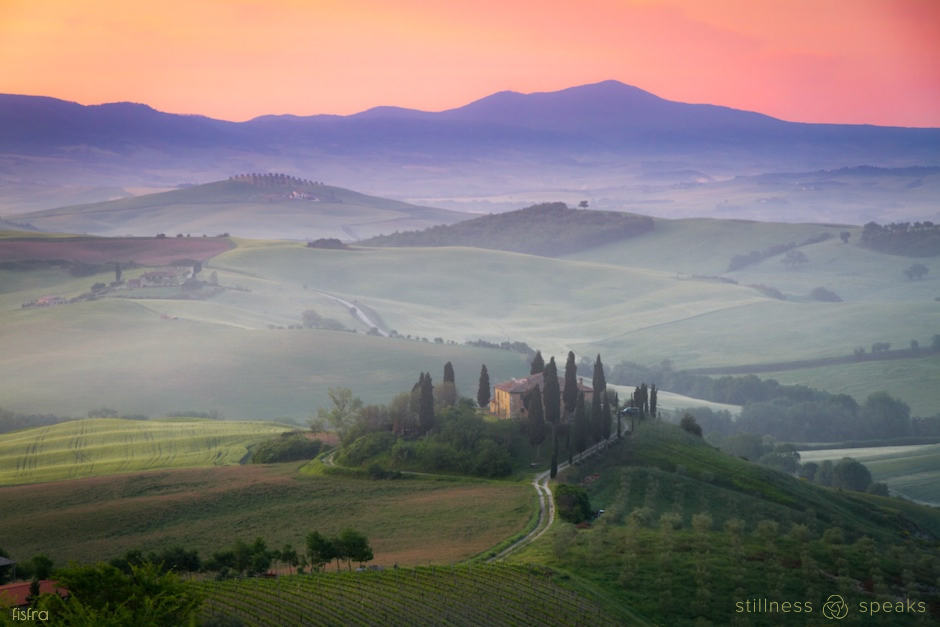Pause: “… Can we take a moment to pause and be aware … of how it is right now, without trying to modify or correct it in any way, but simply being awake to the bare actuality of this moment, just as it is? …” ~ Joan Tollifson
“… Just pause. Nothing else. And notice your experience. Notice what is there. In this moment …” ~ Peter Russell
Our daily life entails responding to stimulus of all kinds arising from an ever changing sea of emotions, almost non stop mental activity, and plenty of physical activity. And anyone on the self awareness journey discovers early on (if not right away) that even the briefest pause in meeting these daily navigations is a gift that keeps on giving, e.g., any emotional reaction to some “attack” is met better after a pause – brief or otherwise …. AND it strengthens the “acceptance muscle,” as Tara Brach reminds us:
“… Learning to pause is the first step in the practice of Radical Acceptance. … Through the sacred art of pausing, we develop the capacity to stop hiding, to stop running away from our experience. We begin to trust in our natural intelligence, in our naturally wise heart, in our capacity to open to whatever arises …”
Plus, pause can be the beginning of a deeper transformation too – as Pema Chodron posits: “… It’s a transformative experience to simply pause instead of immediately fill up the space. By waiting, we begin to connect with fundamental restlessness as well as fundamental spaciousness …”
Of course, the mindfulness movement encourages us to cultivate a “built in pause” – at all times … in any encounter … of any kind … which gives us (along with many other benefits) the gift of serenity, as Thay reminds us: “… In mindfulness one is not only restful and happy, but alert and awake. Meditation is not evasion; it is a serene encounter with reality …” – Thich Nhat Hanh
Just pausing, inherently … makes us be present … be here and now … helps us take in this moment fully … as Thay again reminds us: “… When we learn to stop and be truly alive in the present moment, we are in touch with what’s going on within and around us …”
… and that, of course, can be argued as the ultimate gift … 🙂 …
“… This very moment is the perfect teacher, and, lucky for us, it’s with us wherever we are …” ~ Pema Chodron
It’s no wonder that the list of benefits stemming from pause is a long one …
Turns out the act of pausing can also assist letting go …
In his book Letting Go of Nothing, Peter Russell reminds us to Just Pause – and offers his thoughts on the resulting experience including the benefits – in the form of a chapter (with the same title) … and in this post we offer the full chapter … as part 3 of our multi-part series providing an in-depth preview of his book through excerpts …
… Part 1, was the Foreword by Eckhart Tolle … which set the stage for the series …
… Part 2, was the 1st step in letting go, which is Letting In as per Peter (covered in a chapter named as such) …
This book is An Eckhart Tolle Edition (an imprint of New World Library – the publisher of Peter’s book) that offers “… life-changing works, both old and new, that have been personally selected by Eckhart Tolle … books that can powerfully aid in transforming consciousness and awakening readers to a life of purpose and presence.”
All italicized text below is from Letting Go of Nothing: Relax Your Mind and Discover the Wonder of Your True Nature by Peter Russell and is published here with his generous permission. Peter has also generously offered a free downloadable PDF of the Table of Contents (link is at the bottom of the post).
Here are all of Peter’s posts on Stillness Speaks … and his website – a treasure trove of wisdom: rich, diverse, and valuable content for your journey … and his YouTube channel where he posts videos regularly.
JUST PAUSE
Pause.
Just pause. Nothing else.
And notice your experience. Notice what is there. In this moment.
There will be various perceptions — sights, sounds, smells. Bodily sensations of one kind or another. Perhaps some feelings or a general mood. And most likely, along with these, some thoughts. Maybe some strong ones dominating your attention. Or some fainter ones in the background — some commentary, perhaps, about what is going on or maybe some habitual concern.
When you notice you are thinking, choose to pause it.
Just for a moment.
In choosing to pause, you’re not choosing to do something else but to simply stop following the thought. To withdraw your interest from it.
And then let the attention relax.
You may notice a sense of ease, a feeling of relief, perhaps, a gentle sense of happiness or joy, a sense of spaciousness and clarity, a lightness of being, or some similar quality.
If so, savor it. Enjoy how it feels to pause for a moment.
At times you may notice subtler levels of thinking in the background — reflections on what you’re noticing, perhaps, or other thoughts that have quietly wandered in.
Choose not to follow them either. Let them go for now.
Notice what it’s like to be free of them. Not caught up in doing.
Later, whenever it occurs to you, pause again.
And again …
But don’t let the practice of pausing become routine, as in looking for similar experiences, responding in the same way. Don’t let it become a ritual that you do. For then the practice will lose its value and power.
Make each pause a fresh inquiry into the moment. Be curious about what it feels like — as if it were the first time.
Which it is. The first — and only — time you will savor this moment.
~ Peter Russell
And, click here for the free, downloadable PDF of the Table of Contents.
Stay tuned for more from Peter’s book …
=== ==== ===
The “practice” of pausing, inevitably, makes us gentler with others … and more balanced in our navigations with others …. which ultimately leads to appreciating the oneness of us all … and in that spirit let us minimize (& hopefully dissolve) the current humanitarian crisis unfolding in Ukraine … by helping in whatever way we can … and to that end here are some options:
1) NPR: Want to support the people in Ukraine? Here’s how you can help
2) Washington Post: Here’s how Americans can donate to help people in Ukraine.
3) Go Fund Me: How to Help: Donate to Ukraine Relief Efforts.
4) USA Today: Want to support the people of Ukraine? These apps and websites can help you send money.
— — — —
We are all facing financial challenges but IF your situation allows you to donate and help then please do so …
THANK YOU!
=== ==== ===










